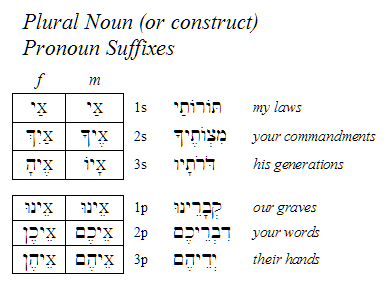|
Hebrew Pronomial Suffixes (Plural Nouns)
Introduction
In Unit 6.7 you learned that pronomial suffixes can attach to the ends of singular nouns. In this unit, you will see how these suffixes can likewise attach to the ends of plural nouns. Fortunately, these suffixes are similar, apart from a few changes which will be explained below.
Hebrew Plural Pronomial Endings
In Hebrew, possession can be expressed by attaching "pronomial" endings to nouns. For example, the word for "words" in Hebrew is devarim. To say "my words," you would add the 1st person singular ending (which is "-ai") to the base form of the noun (devar) to derive devarai (literally, "the words of me"):

Now before I give you the endings you will see on plural nouns, you need to be aware of a few important things:
- Masculine Plural endings are dropped.
When possessive endings are attached to nouns that have a masculine plural ending (-eem), the ending is dropped and the possessive ending is attached directly to the "base form" of the noun (the base form undergoes a vowel change because of the addition of the suffix, however).
- Feminine Plural endings are retained.
When possessive endings are added to nouns with the feminine plural ending
(-ot), the plural ending is not dropped, but the suffixes attach directly to the plural form of the noun.
- Nouns with pronomial suffixes are considered definite nouns.
When you see a suffix on a noun, consider the noun to be definite. Among other things this means that any adjective that follows the noun must take the definite article (since adjectives, when they are used to directly describe nouns, must agree in definiteness with the noun).
Pronomial Endings (for plural nouns)
For plural nouns, the following endings can be attached to show possession:
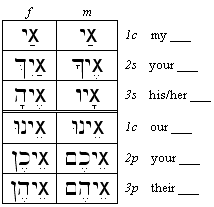
In the paradigm given above, note that the "X" refers to the last letter of the noun.
Some Notes:
- The suffixes look somewhat like those on the ends of singular nouns but are attached to the ends of plural nouns.
- All these suffixes have a Yod stuck between the noun and the suffix. This Yod is the single element in the pronominal suffixes that let you know whether you are dealing with a singular or a plural noun (i.e., whether the word is "your horse" or "your horses").
- The 3ms suffix is a diphthong pronounced "av."
- For masculine nouns, the suffixes attach to what I am calling the "base form" of the noun, that is, the singular absolute form (with vowel changes, of course).
- For feminine nouns, the suffixes attach to the normal plural form.
- You will need to memorize these suffixes so that when you see a noun with one of these endings, you will understand that a possessive personal pronoun is "embedded" into the meaning of the noun.
Example Paradigm: Davarim (masculine plural)
Recall that the Hebrew word for "word" is davar, a masculine noun. The pronomial suffixes are attached to the base form of the noun (the plural ending is dropped). Thus, attaching the pronomial endings listed above, we have the following paradigm:
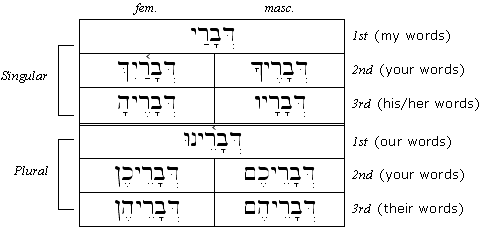
Example Paradigm: Torot (feminine plural)
Recall that the Hebrew word for "law" or teaching is Torah, a feminine noun. In the plural, Torah changes its spelling to Torot, and the pronomial suffixes are attached to this form. Thus, attaching the pronomial endings listed above, we have the following paradigm:
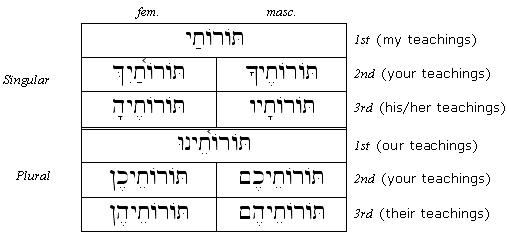
For feminine plural nouns, the noun ending is retained, and the suffixes are simply added to the end of the word.
Irregular Nouns and Pronomial Suffixes
You should be aware that many of the more common Hebrew nouns change their vowels when the pronomial suffixes are added. For example, the Hebrew noun for "sons" is banim, but the pronomial endings are not added to the singular base form (ben) but to plural form with the ending dropped, i.e., ban:

Note, however, that these endings are consistent throughout the paradigm. This same sort of change occurs with the noun for house (bayit), daughter (bat), and other common nouns.
Pronomial Suffixes Summary
The following two tables sum up the information provided in this unit as well as
Unit 6.7. You do not need to memorize these tables, though you should understand why a given form is spelled as it is. These tables essentially summarize the differences between the singular and plural nouns when the pronomial suffixes are added.
Masculine Forms
Many Hebrew grammars use the word for "horse/s" (sus/susim) to demonstrate the inflections made to masculine nouns when pronomial suffixes are added. I include the list here, just in case you want to learn the more traditional paradigm:

Note that in the table above, both the singular noun (e.g., sus) and the plural noun (susim) are listed with the different pronomial endings.
Feminine Forms
For the sake of completeness, the word for "mare/s" (susah/susot) is used to demonstrate the inflections made to feminine nouns when the pronomial suffixes are added:
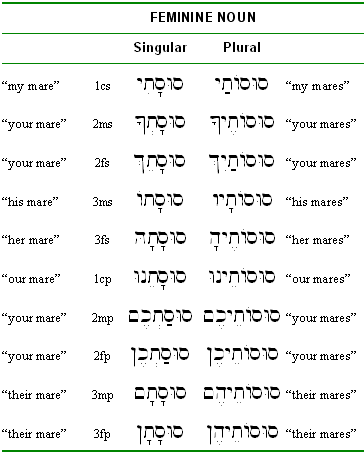
Note that in the table above, both the singular noun (e.g., susah) and the plural noun (susot) are listed according to the different pronomial endings.
Section Exercises
- Memorize the pronomial endings for plural nouns.
- Memorize the masculine plural paradigm for devar.
- Memorize the feminine plural paradigm for Torot.
- Add the pronomial endings to the following words:

- Can you understand the translations of the following phrases? Tip: the noun elohim (God) is singular (though it has a plural form):

- Add the pronomial endings to other singular nouns you have studied. Use your Hebrew lexicon to confirm your work.
Section Worksheet:
<< Return
|
|










